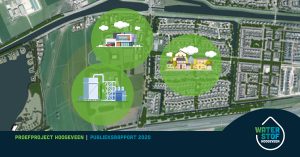Research Waterstofwijk Hoogeveen: hydrogen can also be used in existing buildings

The final report containing the research results of Waterstofwijk Hoogeveen (Hydrogen plan in the Dutch town of Hoogeveen) was published today. The most important conclusion of the two-year study is that existing residential areas can also switch from natural gas to -sustainable – hydrogen for their heating. The specially developed hydrogen boiler makes use of the existing natural gas infrastructure. Heating the ‘built environment’ with hydrogen is therefore not limited to newbuild site construction. The report was presented today during a webinar to the consortium members of the project.
The basis for the implementation of the plan is the Nijstad-Oost demonstration project in Hoogeveen with 100 new homes. The municipality of Hoogeveen, together with the consortium parties involved, will now take the steps to realise the plans: the construction of the hydrogen network and the connection of 100 new homes in Nijstad-Oost. This will be followed by the conversion of more than 400 homes in the existing Erflanden district.
Hydrogen for existing buildings
The study shows that heating with hydrogen in the built environment can be safely used as a substitute for natural gas. The next step is being worked on: converting the existing Erflanden district next to Nijstad-Oost from natural gas to hydrogen and reusing the existing natural gas grid.
Additional solution for natural gas-free living
The project shows the potential of sustainable hydrogen for the natural gas-freeing of part of the Dutch housing stock, reusing the existing natural gas network and using a new hydrogen central heating boiler. This adds an extra solution for making existing residential areas in the Netherlands free of natural gas. In the project, a burner was developed for hydrogen central heating boilers and various components for the boiler were adapted.
Over the past 2 years, the 22 partners in the consortium Waterstofwijk Hoogeveen worked on the research project. Rijksdienst voor Ondernemend Nederland supported this with a research grant.
The results of the research can be found in the final report Proefproject Hoogeveen | Public report 2020 (in Dutch) that was presented today.
Read: DNV GL report DEVELOPMENT OF HIGH PERFORMANCE (LOW NOx) DOMESTIC HYDROGEN BOILERS
About Waterstofwijk Hoogeveen
The Waterstofwijk Hoogeveen project is a collaboration between Arcadis Nederland, BAM Infra Energie Water, Bekaert Combustion Technology, Cogas, DHV Nederland, DNV-GL Netherlands, Enexis Netbeheer, GasTerra, Gasunie, Green Planet Pesse, Hanze University of Applied Sciences Groningen/ENTRANCE, Institute of Physical Safety (IFV) , JP-Energy Systems, Liander, N-TRA/RENDO, NAM, Nedstack, New Energy Coalition, Province of Drenthe, Royal Haskoning, Stork Netherlands, Visser & Smit Hanab and Municipality of Hoogeveen.
Waterstofwijk Hoogeveen is one of the projects in HEAVENN/Hydrogen Valley, a six-year European programme of FCH-JU in which more than thirty public and private parties are building a hydrogen economy in the north of the Netherlands. HEAVENN stands for ‘H2 Energy Applications (in) Valley Environments (for) Northern Netherlands’ and is the first Hydrogen Valley in Europe.

